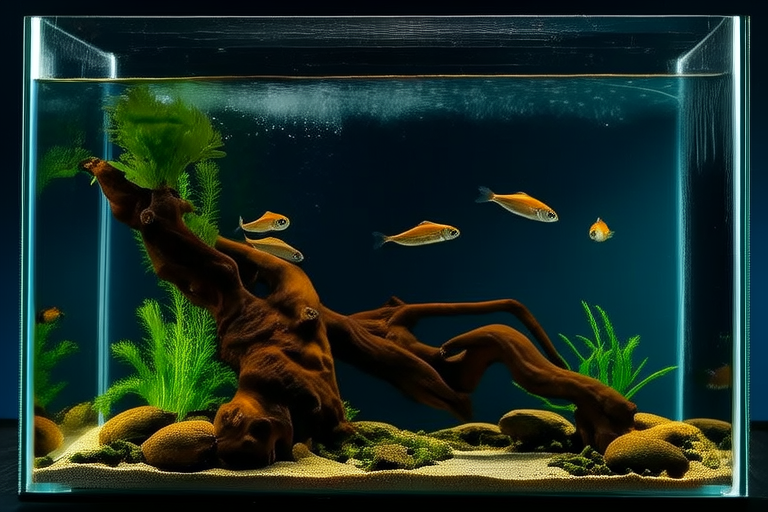DIY Aquascape: Creating a Stunning Underwater Garden for Your Goldfish
Welcome to the world of aquascaping! This comprehensive guide will walk you through creating a stunning underwater garden specifically designed for your goldfish. Whether you’re a seasoned aquarist or a beginner, this project promises to be both rewarding and educational. We’ll cover the basics of aquascaping, essential equipment, step-by-step setup instructions, plant and decoration suggestions, maintenance tips, common pitfalls to avoid, and how to ensure a healthy environment for your aquatic friends.
Introduction to Aquascaping Basics
Aquascaping is the art of arranging aquatic plants, rocks, driftwood, and other ornaments to create a visually appealing underwater landscape. It combines elements of horticulture, architecture, and fine art to produce a natural-looking ecosystem within a fish tank. A well-planned aquascape not only enhances the beauty of your aquarium but also provides a healthy habitat for your goldfish.
Essential Equipment Needed
Lighting
Proper lighting is crucial for the growth of aquatic plants and the overall aesthetics of your aquascape. LED lights are highly recommended due to their energy efficiency and ability to provide full-spectrum light. Ensure that the lighting duration does not exceed 8-10 hours per day to mimic natural daylight cycles.
Filtration System
A robust filtration system is essential for maintaining water quality and ensuring the health of your goldfish. Choose a filter that can handle at least four times the volume of your tank per hour. Filters with biological, mechanical, and chemical filtration components are ideal for removing waste, debris, and harmful chemicals from the water.
Substrate
The substrate forms the base of your aquascape and influences the aesthetic appeal and functionality of your tank. For goldfish, opt for a fine-grained substrate like sand or small gravel. Avoid sharp-edged substrates as they can harm your goldfish. Additionally, consider substrates with beneficial bacteria to aid in nitrogen cycling.
Step-by-Step Setup Process
Choosing the Right Tank
Select a tank size appropriate for your goldfish. Goldfish require ample space to swim freely, so a minimum of 20 gallons is recommended for one goldfish. Larger tanks provide more stability in water parameters and allow for a more extensive and diverse aquascape.
Preparing the Tank
- Wash the Tank: Thoroughly clean the tank with warm water and mild soap, then rinse it thoroughly to remove any residue.
- Install Filtration and Heater: Position the filter and heater according to manufacturer guidelines.
- Add Substrate: Spread the substrate evenly across the bottom of the tank, ensuring there are no air pockets.
- Set Up Decorations: Arrange rocks, driftwood, and other decorations to create a natural-looking landscape. Consider the flow of water and the swimming patterns of your goldfish when positioning these elements.
- Planting: Carefully place aquatic plants in designated areas. Ensure that the roots are securely anchored to prevent uprooting.
- Fill with Water: Use dechlorinated water to fill the tank gradually to avoid disturbing the substrate.
- Introduce Fish: After the tank has cycled and stabilized, gently introduce your goldfish.
Suitable Plants and Decorations for Goldfish
Plants
Choose hardy and fast-growing plants that can thrive in a goldfish tank. Some excellent options include Java Fern, Anubias, and Hornwort. These plants not only add visual interest but also help maintain water quality by absorbing nutrients and providing oxygen.
Decorations
Incorporate natural-looking decorations such as driftwood, rocks, and caves. These elements provide hiding spots and resting places for your goldfish, enhancing their comfort and well-being. Be mindful of the size and placement of decorations to ensure they do not obstruct the movement of your fish.
Maintenance Tips
Regular maintenance is key to keeping your aquascape vibrant and healthy. Perform weekly water changes, clean the substrate and decorations, and monitor water parameters such as pH, ammonia, nitrite, and nitrate levels. Regularly trimming plants prevents overcrowding and promotes healthy growth.
Common Mistakes to Avoid
- Overcrowding: Too many fish can lead to poor water quality and stress. Always follow the rule of one inch of fish per gallon of water.
- Improper Lighting: Excessive lighting can cause algae blooms and stress your fish. Stick to the recommended lighting duration.
- Poor Filtration: Inadequate filtration can result in high ammonia and nitrite levels, posing serious health risks to your goldfish.
- Inconsistent Water Changes: Neglecting regular water changes can lead to the buildup of toxins and deteriorating water quality.
Ensuring a Healthy Environment for Goldfish
To maintain a healthy environment for your goldfish, ensure the water temperature remains between 68-74°F (20-23°C). Regular testing of water parameters helps identify potential issues early. Provide a balanced diet consisting of pellets, flakes, and occasional treats like vegetables. Encourage natural behaviors by offering hiding spots and open swimming areas.
Creativity and Practicality in Designing an Aesthetically Pleasing and Functional Underwater Garden
While aesthetics are important, functionality should not be overlooked. Balance creativity with practical considerations to create a harmonious underwater environment. Experiment with different layouts, plant arrangements, and decorative elements to find what works best for your goldfish. Remember, the goal is to create a space where your goldfish can thrive while enjoying a beautiful and captivating underwater garden.
